What are the best document scanners to buy this year?
Using the best document scanner, you can handle large piles of papers, organize them in a convenient way and immediately save the results to cloud storage. Such devices are convenient to use and they offer more extensive functionality if compared to regular scanning apps.
We have picked the most popular and well-designed document scanners that manufacturers currently offer. Read till the end to learn about their pros and cons, key features, and prices. You are sure to find an ideal option for your needs and budget.
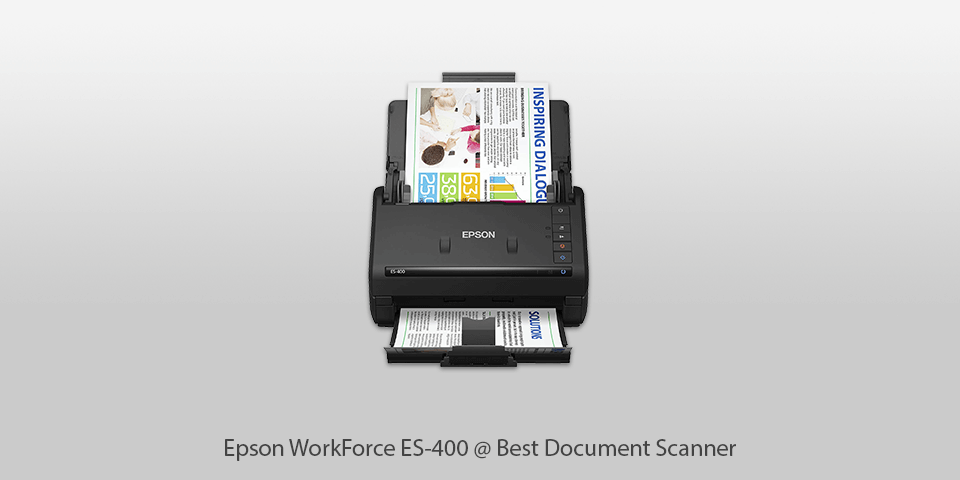
Optical scan resolution: 300dpi | Scanning speed: 35ppm | Interface: USB | Feeder capacity: 50
⊕ Agile scanning to both images and searchable PDFs
⊕ Budget-friendly
⊖ Disappointing OCR
⊖ Fussy document feeder
This desktop document scanner seems like an ideal variant for personal and office use in case you need to capture moderate volumes of papers. It brags about high scanning speeds especially considering that it belongs to a low-cost group of scanners. In fact, it is slightly faster than the much-hyped Canon DR-C225 when it comes to scanning both to images and searchable PDFs.
The weak point of this model is inaccurate OCR performance, which is really disappointing and makes WorkForce ES-400 inappropriate for scanning to DOCX format. If you mainly work with PDR files, that shouldn’t be an issue for you.
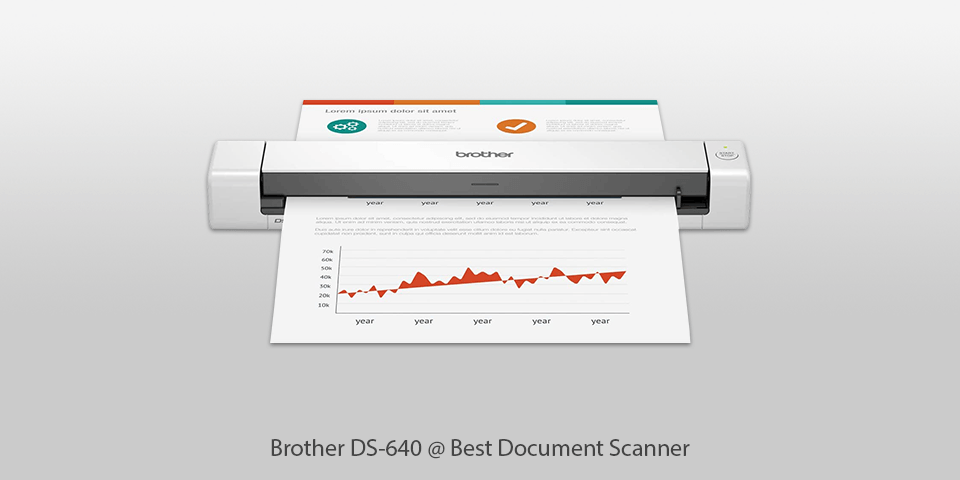
Optical scan resolution: 600dpi | Scanning speed: 16ppm | Interface: USB| Feeder capacity: 1
⊕ Scans and processes files quickly
⊕ Precise OCR
⊕ Compact and lightweight
⊕ Straightforward operation
⊖ Deprived of single-pass, duplex scanning and lacks ADF
⊖ Comes without an app for business-card archiving
⊖ No integrated battery
Being a representative of the DSmobile lineup, this personal document scanner boasts portable dimensions and offers all the necessary features for dealing with files on the go. Thanks to such a compact size, you can take DS-640 with you on a business trip and effortlessly scan the necessary docs.
However, mind that there is no duplex scanning feature, so the process will take quite long especially if you have to scan bulks of papers. The most frustrating thing is that the scanner comes without a dedicated app, which means you have to buy one separately to cope with archiving tasks.
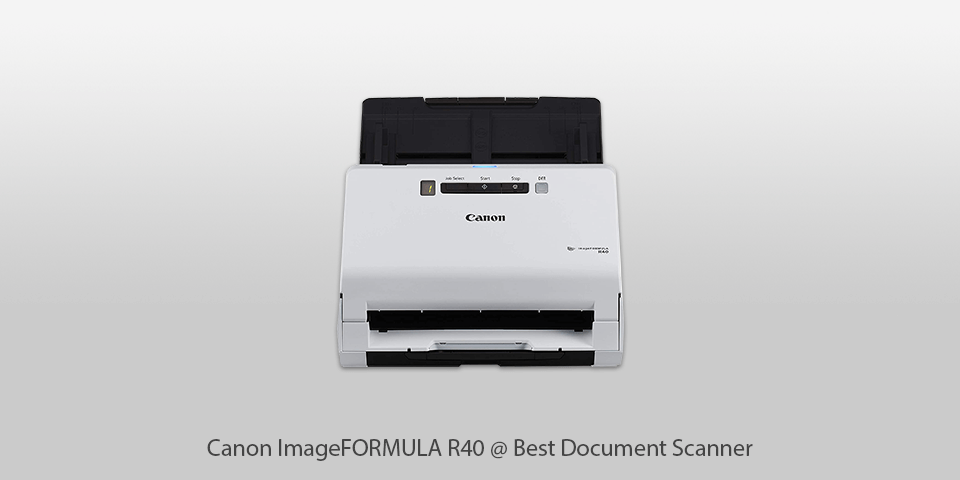
Optical scan resolution: 600dpi | Scanning speed: 30-60ppm | Interface: USB | Feeder capacity: 60
⊕ Great OCR
⊕ Full software package
⊕ Amazingly fast scanning
⊕ User-friendly device
⊖ No network and mobile connectivity
Among a huge variety of scanners for documents, Canon ImageFORMULA R40 managed to find its place in a niche aimed at people looking for the best high resolution scanner with a set of regular features. The peculiarity that may scare off some buyers is the lack of network and mobile connectivity, so if this is a crucial point for you, keep on searching.
Another thing to remember about is that this scanner can’t compete with more portable machines as it occupies rather much desktop space. If such downsides don’t matter, you can safely rely on R40 for most scanning tasks.
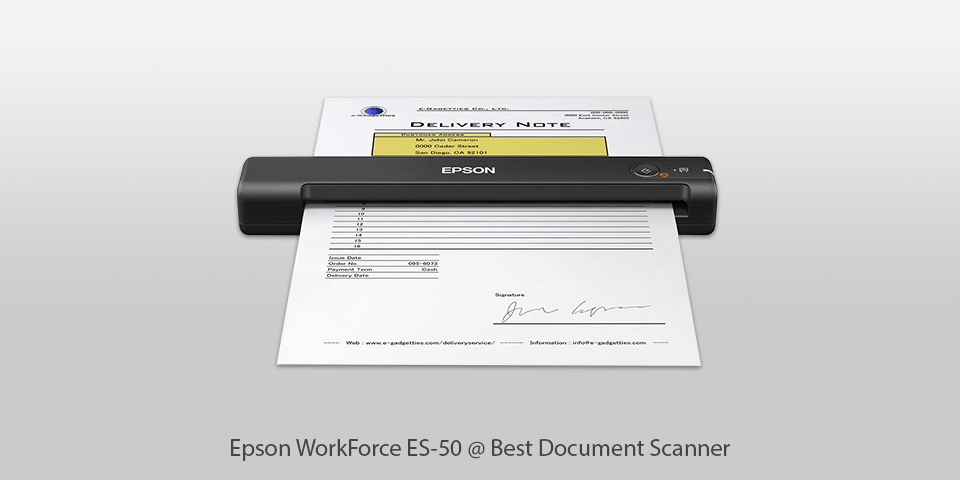
Optical scan resolution: 600dpi | Scanning speed: 10ppm | Interface: USB| Feeder capacity: 1
⊕ Small size and weight
⊕ Works quickly
⊕ Top-notch OCR
⊕ Handy software
⊖ No memory card support
⊖ Without embedded battery
⊖ USB connection only
Being a remarkable, budget-friendly scanning device, WorkForce ES-50 will especially appeal to those people, who are accustomed to working on the go and want to have a machine that can withstand such a pace. Just connect it to your laptop and start scanning. It weighs about 10 ounces and won’t tire your hands while carrying it from one spot to another.
The only accessory you need to pack in a bag is a USB cable. If you are looking for absolute mobility and messing up with a cable seems inconvenient, then opt for ES-60W document scanner for Mac and Windows OS. In other cases, ES-50 is a reliable assistant.

Optical scan resolution: 600dpi | Scanning speed: 25ppm | Interface: USB| Feeder capacity: 20
⊕ Quick scanning and text recognition
⊕ Great OCR performance
⊕ Comprehensive software pack
⊕ You can choose scanning to a USB drive
⊖ Battery should be bought separately
⊖ Not really lightweight
Brother ADS-1700W is a direct rival of Epson ES-400 since they are both portable scanning machines with slight differences in the construction that serve as a basis for this competition. If you are shopping for a travel-friendly scanner with a built-in battery that allows you to work on the go, then you should opt for a scanner from Epson.
In case you feel more interested in the possibility to scan to USB drives, then Brother product is the best document scanner for your needs. Besides, mind that Epson scanner costs $30 more and if this price is fully justified by the abundance of handy features, it may be too high for some users.
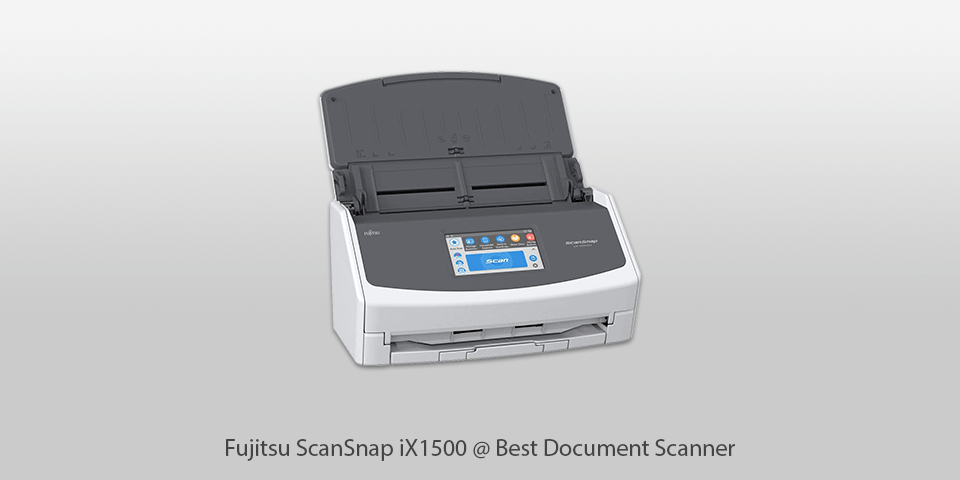
Optical scan resolution: 600dpi | Scanning speed: 30ppm | Interface: USB| Feeder capacity: 50
⊕ Great OCR
⊕ Amazing software pack with financial data support
⊕ Numerous connectivity options
⊖ No Ethernet support
Those searching for a light-duty office document scanner, should give ScanSnap iX1500 a thorough study. In addition to basic features, this device is capable of scanning receipts and delivering impressively detailed results. However, it lacks Ethernet support and this deficiency may be decisive for some buyers.
Another factor to keep in mind is a somehow hefty price if compare with similar scanners for work with documents. If none of the above-mentioned drawbacks is important to you, then ScanSnap is bound to satisfy your demands.
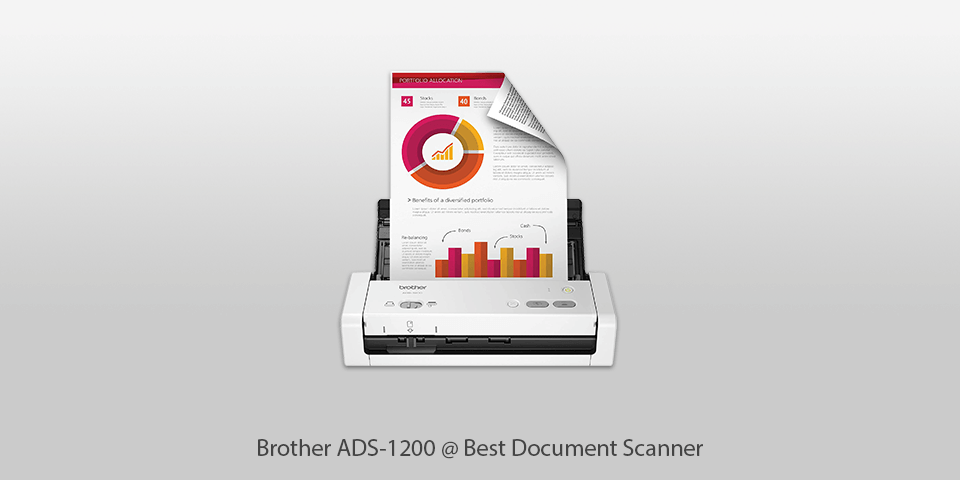
Optical scan resolution: 600dpi | Scanning speed: 25ppm | Interface: USB| Feeder capacity: 20
⊕ Small size and weight
⊕ Up to 25 minutes of duplex scanning
⊖ No Wi-Fi support
⊖ Lacks network connectivity
Users prefer this document scanner for its travel-friendly dimensions that ensure convenient text processing far from working place. It is the same width as an A4 and weighs only 1.4kg. You can easily fit it into your bag and start scanning on the move at the speed of 25 pages per minute. The availability of the duplex scanning feature makes the process really fast.
Not only can handle this personal document scanner A4 papers, but it also has a special built-in slot for ID cards. A USB connection time allows for smooth transferring of docs to a PC or laptop. Last but not least is the ability of ADS-1200 to recognize blank pages and prevent paper wrapping.

Optical scan resolution: 600dpi | Scanning speed: 16ppm | Interface: USB,Wi-Fi| Feeder capacity: 20
⊕ Compact and lightweight
⊕ Agile scanning and processing
⊕ Great OCR
⊕ Nice software bundle
⊖ Lacks automatic document feeder
⊖ Supplied without MicroSD card
This home document scanner has set new standards in such areas as speed and accuracy motivating other manufacturers to devote more time to the efficiency of their products. It comes with a full software pack and if you complement it with a MicroSD card, you’ll be able to store your scans right there.
Small dimensions add convenience to the scanning process if you work on the go. All in all, Brother DS-940DW with manual-feed technology is a decent option for average users.
| Image | Name | Features | |
|---|---|---|---|
 |
Epson WorkForce ES-400
Our Choice |
CHECK PRICE → | |
 |
Brother DS-640
Budget |
CHECK PRICE → | |
 |
Canon ImageFORMULA R40
Office |
CHECK PRICE → |

Though most scanners for documents are designed to cope with regular tasks, each of them approaches the process differently. Finding a model that can fully satisfy your needs is a time-consuming endeavor. However, using the recommendations given below, you’ll be able to cope with it faster.
The first thing to consider is the type of documents you are going to scan. In most cases, this refers to scanning loose documents and photos. The source quality of the latter depends on whether you use the best digital camera for photographic documents or a simple phone. An average office and home documents scanner can handle it.
If you plan to scan more specific kinds of media – ID cards, stamps, magazines, books, 3D objects, then you should choose a device designed for such a purpose. Besides, check the max media size in relation to the width of a scanner.
All scanners can be divided into 2 groups – flatbed and sheet-bed. Those belonging to the first category have a big glass platen where you place a document or object for digitizing. Sheet-fed machines run documents through the scanning system.
People opt for flatbed scanners because of the convenience of scanning and delicate handling of the originals. There is no risk of damaging them. Sheet feeders are more fitting for scanning long, one-piece papers.

A duplex desktop document scanner captures both sides of a paper at once. If you need this feature on a regular basis, you should invest in such a machine. Its working speed is higher than that of a single side scanner.
Resolution acquires greater importance if you plan to scan slides and negatives and need to capture all the details. High-res scanners amaze with the quality and vividness of digitized copies. If you work with papers, receipts, contracts, this parameter plays a less significant role.
What is the largest size of a document you are going to scan? Answer this question and you’ll understand how big a scanner you should buy. In general, sheet-fed scanners perfectly cope with capturing long single-page docs. However, there are some flatbed models with an extensive platen that can handle large papers.
It is advisable to invest in an office document scanner that comes with dedicated software enabling you to perform various editing actions with your digitized copies. Though such machines tend to cost more, your expenses are fully justified by a variety of hi-tech functions you receive.
A scanner supplied with a full pack of programs can easily edit images and text, produce searchable files, archive business cards, and more.
Consider the resolution. 300 DPI is a good value in most cases. 1200 DPI ensures exceptionally high quality and 3200 DPI is ideal if you want to enlarge your digital scans.
There are special kiosks for such a purpose. If you are interested in film development, you need to fill out a film processing envelop and send via Dropbox. Then specialists will take care of your order.
If you don’t have a home document scanner, you can download an app and use it to digitize your images, docs, receipts, etc.
Epson Perfection really wins in this category, pleasing users with 4800 DPI optical resolution, 10-sec scanning speed, and absolutely intuitive controls.
Yes, they can. They typically have USB or wireless connectivity options that allow for direct transfer of scanned files. Thus, users can save their scanned documents in various formats (such as PDF or JPEG) directly to their desired location, such as a computer hard drive, USB flash drive, or cloud storage.
Yes. Many document scanners have the capability to scan photos and other types of media, such as film negatives or slides. They often provide high-resolution scanning options and color depth settings to ensure accurate reproduction of images. This makes document scanners a versatile tool for preserving and digitizing various types of documents and media.
Firstly, you can have efficient and organized storage of documents in digital formats, reducing physical clutter and saving physical space. Secondly, digital documents can be easily searched, retrieved, and shared, leading to improved productivity and collaboration. Lastly, document scanners often provide features like automatic text recognition (OCR) and image enhancement, enhancing the readability and accessibility of scanned documents.
Yes, it can. Some document scanners have specialized features like receipt scanning modes, business card recognition, and adjustable paper trays to accommodate different sizes. Moreover, certain scanners offer software functionalities to optimize the scanning process for specific document types, ensuring accurate and high-quality results.

 Rating
Rating